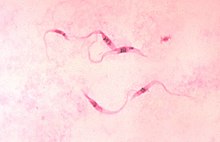Trypanosomes
| Trypanosomes Temporal range: Albian to Recent 100–0 Ma |
|
|---|---|
 |
|
| Trypanosoma cruzi parasites | |
| Scientific classification | |
| Domain: | Eukaryota |
| (unranked): | Excavata |
| Phylum: | Euglenozoa |
| Class: | Kinetoplastea |
| Subclass: | Metakinetoplastina |
| Order: |
Trypanosomatida Kent 1880 |
| Family: |
Trypanosomatidae Doflein 1901 |
| Genera | |
Trypanosomatida is a group of kinetoplastid excavates distinguished by having only a single flagellum. The name is derived from the Greek trypano (borer) and soma (body) because of the corkscrew-like motion of some trypanosomatid species. All members are exclusively parasitic, found primarily in insects. A few genera have life-cycles involving a secondary host, which may be a vertebrate, invertebrate or plant. These include several species that cause major diseases in humans.
The three major human diseases caused by trypanosomatids are; African trypanosomiasis (sleeping sickness, caused by Trypanosoma brucei and transmitted by tsetse flies), South American trypanosomiasis (Chagas disease, caused by Trypanosoma cruzi and transmitted by triatomine bugs), and leishmaniasis (a set of trypanosomal diseases caused by various species of Leishmania transmitted by sandflies).
The family is known from fossils of the extinct genus Paleoleishmania preserved in Burmese amber dating to the Albian (100 mya) and Dominican amber from the Burdigalian (20-15 mya) of Hispaniola. The genus Trypanosoma is also represented in Dominican amber in the extinct species Trypanosoma antiquus.
...
Wikipedia
